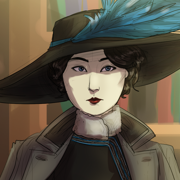|
Mani
|
|
|
|

|
| # ? Jun 7, 2024 15:44 |
|
Mani Just for something different and interesting.
|
|
|
|
Too late perhaps but Old Ways. Hell, a reformed scythian run in CK3 would be fun too.
|
|
|
|
13: Cage the Elephant Lecture 13 in HIST243: Europe in Late Antiquity Gunacamdre’s fierce defence of the ‘Old Ways’ - of Tapatī́ and all the lesser and greater spirits of the world - made him many enemies in court, with most of the nobility given over to either the cult of Jesus or the new religion of Light. Spending much of his days travelling around the North holding court, he was seen as a weak, absentee king by many of the notables of the realm - a fact which he was well aware of, and resentful about. On one of his brief tenures in Pella, he noted that Sythia, alone amongst the great powers, had neither the ability for the King to pass his throne to his child, nor limited periods of kingship to deal with situations which inevitably arose when ‘half-wits and lunatics’ were either elected to the throne or left to languish pass their prime, with the de-facto coup of Katarni in his senility being cited as one of the flaws of the Sythian ad-hoc governmental system  Gunacamdre’s preference for a monarchy - thus guaranteeing, in his mind, the defence of the worship of the old gods - was well known by the court. As political intrigue swirled, unlikely alliances were forged between disperate houses. Most notably, a minor dispute over property ownership between two of the lesser nobles - Ayardhyame and Sagare - rapidly escalated, with the Helleno-Sythian Christian nobility siding for Sagare’s claim that a woman’s claim on a piece of property was inferior to any man’s, and the Manichean cult promoting strict equality between noble’s property rights. After executing a minor preacher who had gotten ahead of himself and called for equality between the slaves and nobility, Gunacamdre came down in favour of Ayardhyame, citing the Bara Atuyyca as proof that Sythian women had long had property rights. In the process, he began to reconcile himself to the cult of Mani (which had several members semi-openly plotting against him) but also the nobility as a whole, as siding with his enemies in the high-profile dispute did much to raise his image as a truly fair judge.  Whether it would have been enough to secure general assent to Gunacamdre passing the throne directly to his son will never be known. A mere two weeks after the trial (and 4 days before the council was due to convene again), Gunacamdre was found dead by his slave when he went to rouse him. Dark rumours swirled of poison and assassins, but in the paranoid currents swirling Pella in the summer heat there was no person trusted to manage a real investigation, with the Agarid family - staunch opponents of hereditary monarchy (apart from that one time they tried to launch a coup and plunged Scythia into civil war) - making it clear that any accusation against them would plunge the capital into open bloodletting. It is perhaps the cruellest of ironies that Gunacamdre’s attempt at reforming the Sythian government - avoiding the peril of insane or senile rulership which had so plagued it in the past - had left the capital and nobility at such a point where open kinstrife could only be avoided through the election of such a candidate, with Aryamarg I - a 61 year old noble of the pro-Gunacamdre, pro-Monarch Yarkam house securing his election, as the Republicans thought his insanity would prove the need for term limits on rulers, the Yarkams were unable to vote against their own house head, and the minor nobility thought his insanity would free them from oversight. After all, it wasn’t as if Sythia was in need of a strong leader - the fields were fertile, the ports bustling, and the Kushan to the east embroiled against Parthia.  Initially, the nobility was proven right - on the local level, many of the more minor fiefs were made hereditary, with the Istrogothic lands given over to the Amaling family ‘in perpetuity’ according to Gothic court annals, which those of you taking Professor O’Faloaf’s paper on Early Medieval Europe may recall. Even on the international level, ambassadors to foreign realms appear to have been passed directly from parent to child (for more detail, Letters from Chalcedon covers nearly 70 years of correspondence between a Scythian ambassadorial family at the lucrative Bosphoran posting and their relatives and friends at the capital, though the nature of their work does mean the casual reader will have to wade through extensive discussions around tariff rates and the grain trade - of invaluable assistance to the professional economic historian, and as interesting as watching drying concrete for the layman. I would recommend the revised edition from Deograh University Press, as well - their understanding of Scythian court etiquette will assist in getting so much more out the text).   The dilemma that Scythia found itself in at this point was the classic one of most states in late antiquity - the noble class had interests that were not linked to that of the state, but were linked to the local level - their own fiefs and hunting grounds. While Aryamarg was content to ‘reign’ from the palace, provided no servant tried to make eye contact or move in his presence, the nobles busied themselves effectively looting the state to construct improvements and infrastructure in areas they held personal rights over, with a massive expansion of roads and farms throughout the regions, which was in turn met with a restriction of rights of the slave classes to move. Indeed, in recorded transactions between the nobles, it was more and more common for land being sold to come ‘mehelot’ - ‘with [the] helots’, with the slaves being considered part of the land rather than the private property of the land owners.  So, we have a growing lesser nobility who see their interests as lying away from the capital and a weak central government. Who can tell me what happens next? Yes? No, sorry, I’m afraid that we won’t be getting to the Huns until after the winter break, but good guess - for someone who clearly didn’t do the reading. Anyone here who did who can tell me the answer? You’ll get much more out of these lectures if you come prepared, guys. Yes, that’s right - it’s the Illyrian War. And can you tell me why it’s called that? No, that wasn’t in the reading, you’re right. There’s actually two reasons - the first, of course, being that for our Scythians sources, who are primarily interested in themselves and their countrymen, most of the fighting occurs in Novae Roma. Secondly, as we’ll get to in a moment, the Scythians are led by Tukik ‘Illyria’ during the war, as he was the governor of Scythian Illyria and therefore the first man on the scene. We’re not sure exactly, but it seems unlikely he was ethnically Illyrian - he was a member of the notable Ytarim family and the high Scythian nobility tended to, with some exceptions, marry amongst themselves. Where were we? Ah, yes, so Dacia starts a war with Carthage - to this date, no one knows why. Relying on Scythia to intervene? Madness? Thinking the Sufet isn’t watching, despite the Po valley being one of the most guarded frontiers on earth? A slave-raid across the border which went wrong? No one knows, and anyone who pretends otherwise is lying to you, I’m afraid - one of the great mysteries of history. Anyway, Dacia is at war with Carthage, and is clearly going to lose.  Now Tukik is just a governor of a semi-poor province at this point, but it’s the western outpost of Scythia and the border with Novae Roma (note for the exams: Novae Roma is not the later State of of Novarum, do not answer ‘Novarum’ to any question when you mean Novae Roma!). So, he’s both the man on the scene and the one who knows what’s going on. This is an age before radio or telegraph - it could take 6 months for a message sent from southern Hellas to arrive in the North! So, to a large degree, he’s the one who’s got to make the decision on how to initially respond. That said, he’s not the King - while he can order the warhost to muster, he can’t - or at least he’s not supposed to - be able to order it to march, that’s the King’s job unless Scythia or its subjects are attacked directly. And that hasn’t happened - Dacia has started a war, but Scythia is only sworn to its aid if it’s attacked. Now, all our sources are after the fact and hagiographic being written in or after Tukik’s later reign (including his memoirs). That said, what they say - and bear in mind while they present him as clever it’s not the most flattering portrayal otherwise, so it may be somewhat accurate - is that he orders a Roman ship in the harbour at Epidamnos to interdict the Punic galleys which are shipping legions over from Aegypt. Of course, he doesn’t have the authority, strictly speaking, to demand anything - the Roman ship is subject to the Roman dictator’s orders, not some Scythian governor. And as for the demand the Carthaginians turn around - on what basis? Anyway, Malchus Gerbalid, the Punic admiral, tells the Roman galley to get out of the way or be fired on. At this point, Tukik has got all he needs - the Punics are (threatening to) attack a bona-fide, no-questions-about-it Scythian subject! Call the warhost and summon the nobles, it’s time for war!  So there’s some minor skirmishing, most of which goes poorly for the Scythians as they attempt to secure the towns and villages around Istria - a name which, like most of mediterranean geography, the Scythians shameless stole from their Roman subject's maps (ooc: went down a two-day rabbit hole trying to find terms for africa/germany/italy which weren’t latin derived, turns out extinct languages don’t leave you a lot to work with so the reason we use latin is that the roman christians have made latin a lingua franca for traders and other users of maps despite rome being a minor adriatic state). So falling back to the pass at Emona, Tukik rallies the men (allegedly) and they ride out and meet the Punic legions head on. The narrow pass is of great assistance, as the legions struggle to manoeuvre to use their numerical advantage, and the mobility of the Scythian horsemen means that the Scythian line wavers but never collapses. Oh, and according to our sources Tukik ‘hews a thousand heads’ and ‘slays the great grey beast with his lance’, teaching the Scythians how to kill elephants - if any of you repeat that uncritically on the test, you’re failing.   The Carthaginians are crushed, however - it’s only thanks to the ill-discipline of the Scythian nobility that the legions aren’t destroyed entirely, with the Scythian nobles more interested in pillaging the Punic camp and wartrain than riding down the fleeing soldiers. Tukik promises more loot if they follow him, and they push to the old Italic fort of Altinium in the marshes of Venetia, laying siege and preparing to loot their way down Italy. Carthage is no disorganised barbarian state however - commanding the sea, they’re able to bring up reinforcements from Cyrencia and the numidian hinterlands, and the legions routed at Emona are re-organised. The Punic accounts we have from the war - this being one of a handful of wars in antiquity where we have somewhat reliable accounts from both sides - seem to indicate that a death sentence was pronounced on all members of the officer corps at Emona, but that the sentence was ‘suspended’ - in other words, ‘fix your mistake or we’ll kill you’. And so it was that a mere two months after Emona, Carthage could put another army of equal size in the field at Venetia.  Those of you who did do the reading will remember that the narrow pass at Emona suited Tukik and the Scythian host wonderfully - confined and narrow, but with clear ground well-suited to horses. Altinium is almost the exact opposite - there’s a dozen passages through the marsh, but cavalry which charges forward regularly sink into a mire or are halted by deep water and are promptly pelted to death by slingers or archers. Meanwhile, the Punic navy is able to use the deeper channels to harass and confine Scythian movements, and the defenders of the fort are seeking to break out and relieve the siege. According to Tukik’s memoirs, of course, everything would have been fine if the nobility had simply obeyed him and his orders, but the Punic account seems to be clear that the battle was completely one-sided, resulting in a general rout of the Scythian warhost.  So Carthage, after two bloody battles, has won local supremacy and just needs to prosecute it’s advantage to win the war. The problem here for the Punic leadership is that now they are in the horns of a dilemma - their logistics and resupply rely on their powerful fleet, but to crush Dacia and Scythia they need to penetrate deep inland across Pannonia and down the hills of Illyria. This can’t be done en-masse - while they’re able to wipe out the Scythian army mustering at Trieste down to the last man, marching 200,000 men as a single unit into Pannonia proper would result in mass desertions and starvation - pre railroads, it simply could not be done without control of the waterways to deliver food and supply to the army as it moved. And the waterways of Illyria and Dacia are well out of reach of Carthage - any fleet sailing up the Istros would be annihilated, there’s no naval supremacy that will get you through 500 kilometres of the enemy controlling both banks, but you can’t take the banks if you can’t resupply your army. So the Punic legions have to disperse and attempt to take forts across Pannonia and Illyria, being unable to travel as one unit.  Of course, Scythia faces a similar dilemma, and it doesn’t even have the advantage of control of the punic sea - with the initial army scattered and the baggage train drowned, sunk or captured in the Venetian marshlands, their reconstituted troops are restricted to whatever food they’re able to ‘requisition’ off the local populace. As the Punic legions spread across Pannonia and down Illyria, the war transitions into a long, grinding series of skirmishes and sieges of key granaries and cities as each side attempts to starve each other out. The first to die, of course, are the civilians unable to flee or hide, but as the war progresses through the first, second, and third winter even soldiers start to drop. In Scythian troops, this manifested itself as a series of mutinies and attempted ransoming of nobility.  The issue the mutineers and wider nobility ran into at this point was that the only person with the authority to intervene in the relationship between a noble and his bondsman, even if those bondsmen were openly threatening the noble, was the King himself - and the King was in no position to be able to do so, with it being doubtful that the King even understand there was a war on. Ultimately, this was untenable - and there was clearly only one man who could command the respect of the warhost and turn the situation around, even if he was somewhat responsible for the war itself.  Whipping the nobility in front of their own troops did little to endear the new King to the other heads of the Great Families, especially when they were not excluded from the punishments being handed out for ‘failure’. For the common soldiery, it did much to reassure them that the King would not fail to mete out consequence for treason or ill-performance, or for hack-handed commanders bungling operations. Reconstituted and re-supplied, the army was once again sent forth to retake Dacia (which had its capital alone change hands 4 times in the war) and Illyria, including Novae Roma.  Carthage had not been idle during the Scythian ‘soft coup’, and it was mere matter of months after Tukik’s coronation that Pella itself found an army outside its walls, forcing Tukik himself to return his army from campaign to prevent the capital’s fall,followed by a Eastern march to retake the Scythian side of the Bosphorus Strait, which had fallen to Punic marines. Between Illyria, Pannonia, and now landings all along the coastline, both Carthage and Sythia were vastly overstretched, with every local advantage in one front mirrored in a crippling deficit in another.  While Pella would see siege thrice in the campaign, most analysis emphasises the low quality of troops committed against the capital’s formidable walls - peasant levies rather than legionnaires - as indicative of the attack’s function being primarily a feint to draw troops away from other fronts and landings. That said, the ‘penal legion’ theory favoured in the 60’s is widely dismissed today, despite its continued repetition in popular culture. The strain of the campaign began to show on the Scythian commanders as well - Nanadabala, the nephew of the former 'King' Aryamarg, brought the realm to the very brink of civil war, disobeying direct orders to march East and reinforce the Illyrian situation to instead march north to relieve the Dacian capital. It was only on hearing that the Agarid host was already laying siege to the capital - and that the Agarid’s would attack him on sight as a traitor if he didn’t obey Tukik - that he finally acquiesced, wheeling west on his arrival in Moesia at the Alaming court.    As that little incident nicely demonstrates, at this point the ‘armies’ of Carthage and Scythia have - and this is nearly 15 years into the war - descended into mobs of armed bandits, looting and pillaging their way across Illyria and Pannonia. One such mob crosses the Carpathians during the summer after looting their way west across Dacia to burn the border city of Tamasidava, destroying the loyal temple of Zalmoxis (maybe. We’re unsure of the exact deity worshipped, but evidence does seem to point towards it being more important to Dacian travellers than the Scythian locals). Another gets as far as Wusun. That doesn’t mean Carthage is winning, though - Scythia has mainly ‘liberated’ Dacia and Novae Roma (‘liberating’ the peasantry of the region of their food, valuables and lives in the process, as was the custom in ancient warfare) but the officers are almost point-blank refusing to push further West into Italia. Finally, tired and exhausted after nearly 2 decades of back-and-forth siege and counter siege, skirmish and ambush, Dacia and Carthage throw in the towel - there shall be, at last, peace. Now, I know that’s the bell, but just wait a second - two notices. First, I expect you all to do the reading for the next lecture of the Council of Deogarh - what motivated the Shahanshah to convert to the Jesus-Cult? I will be calling on some of you at random to tell me what the 10 Canons of the Council were and why the Western ecclesia split from the wider Messianic world and were labelled ‘Christian’, so make sure you read the handouts! This is important - the cult of St Andrew was a particular favourite of the Scythian armed forces, receiving some royal patronage under Tukik during the Illyrian War.  Secondly, next week we’ll be looking at the Scythian government in late antiquity - when Gunacamdre’s abortive reforms were taken up by Tukik, what was the economic and class motivation for the nobility to do so?  OOC: another ‘simultaneous’ update coming followed by two votes.
|
|
|
|
Interlude: The council of Deogarh The conversion of the Shahanshah to the Christ-cult (as it was known in the West) was the production of two factors. Firstly, with the loss of the fertile Mesopotamian lowlands to the Celts, the Shahanshah’s traditional powerbase and source of royal revenue was lost. While state revenue was made up for by the conquest of the Indus, the traditional royal lands to the west - the personal fiefdoms of the Arsacid dynasty - were lost, and the king began to lean more heavily on the predominantly Christian merchants coming via the eastern routes for support, forming a royal guard of baptised soldiers. Secondly, the traditional status of the Shahanshah as warrior-king was shaken by the sacking and desecration of the ‘eternal’ flame of Ādur ī Gušnasp, a act which not even Alexander himself had stooped to. In Parthia itself, meanwhile, the teachings of the Christos were rapidly spreading, offering to many a spiritual respite from the traditional Iranian caste system. Many scholars, looking back, have noted with interest the apparent parallel between the challenges posed by the Indo-Greek kingdom and its adoption and sponsoring of Buddhism to the Brahmanic Hinduism of the remaining subcontinent. While the followers of Jesus were renowned for fellowship across borders, the mingling of religious currents in Parthia often spilled over into violent disputes between different factions. In particular, in the city of Deogarh (in the local tongue the ‘stronghold of giants’, known in the Hellenic world as Alexandria-on-the-Indus) violent riots between the followers of Gaspar - scion of a lesser son of the Great House of Suren, one of the earliest promoters of the Christ-Cult in the East, and the followers of Stasanor, a mystic beloved by the peasantry. The two had fallen out over a dispute around how the Son was related to the Father, with Stasanor preaching that Jesus’ baptism by John was the moment he was ‘adopted’ by the Father due to his personal righteousness and enlightenment against Gaspar’s claim that Jesus was divine ‘before all ages’. While apparently academic from a distance many centuries removed, the dispute between the two often saw mobs attacking the other side, causing many Christian merchants to avoid the city for fear of attack. Summoning ‘all those who profess the faith in the Messiah’ to meet in Deogarh, Datames announced his wish to ‘resolve the disputes which have so divided brother from brother’ so that ‘peace and harmony may reign’. While many elders and presbytes proved unable to attend, the council saw representatives from all corners of the world, with representatives from ecclesia in Punic Gaul, Aegypt, Novae Roma, Phoenicia and far Cathay in attendance. The bulk of the presbytes were, however, Parthian or Bactrian - the distance for them to travel being much shorter, and the issues being raised seeming much more pressing for them. In recognition of the venue and as a concession to the ‘Stasanori’, who were generally less educated and knowledgeable in fewer tongues than the wealthier Parthian delegations, the council itself was held in Greek. That, however, proved to be one of the few concessions made to the ‘Stasanori’ - the council quickly formed a strong majority against the proposition that Jesus was anything less than divine. In particular, the notion that Jesus’ baptism had elevated him was condemned - to the grave concern of the Western representatives from Novae Roma and the Punic world, who pleaded that the baptism had ‘anointed’ Jesus as the Son of God. The Eastern bloc, however, was unyielding - Jesus was to be referred to as the ‘Mashiack’ (the ‘Messiah’) as opposed to the ‘Christos’ (the ‘Anointed’), as had been the custom in the Western churches. While Christological debates were the highest points of contention in the council and were the ultimate cause of the subsequent schism of the Western churches, various other reforms were advanced to standardise and harmonise the various customs of the Messianic ecclesia. Of particular concern was the status of various monks and ascetics who were, in the eyes of the Eparchs (the title for a cleric of a particular exarchate, which in turn drew its title from the term for a traditional Persian administrative area, with particularly notable exarchates styled as a ‘archexarchate’), under concerningly little supervision and oversight, and given to heterodoxy and theological waywardness. That said, the ‘Mountain Fathers’ were still considered key parts of the Messianic faith, with many monasteries in Bactria and Tibet serving as key waystations for Christian travellers. While in the East the Canons of the Council were given respect and obedience, albeit in fits and starts - most notoriously, 11 years after the council Datames himself dismissed Gaspar from court, banishing him to Phoenicia for some two decades and hosting Stasanor at court before acceding to the requests of the Partian Eparchs to reverse course - the position of the West was dramatically different. The Archeparch of Novae Roma and Alexandria outright rejected the council, issuing their own condemnation of ‘those who deny Jesus is the Christos, with Phameas of Alexandria particularly aggrieved at the lack of recognition of the traditional rights of his Archexarch in favour of the Phonecian Jerusalemite see. From a cynical point of view, it is notable that the two powers with the most Manichean sympathies in their elite were the ones which had their Eparchs break from the council. The Phonecian representatives, mindful of their own status as a the custodians of the heartlands of early Messianism were more guarded - while they advocated dialogue and continued inter-communion between the West and the East, the Western representatives withdrawing from the Council alongside Stasanor gave the Eastern claims that the West had been ‘corrupted’ by Mani and other ‘false prophets’ significant credibility to Phonecian eyes. To make matters worse, Phameas, in his anathematization of the Council claimed that the Archeparchs of Jerusalem and Antioch had ‘sold their souls and the heritage of the blessed apostles’ for ‘false dominion’ over the Punic sea. The 10 Canons of the Council posted:No eunuch shall be raised to the presbyterate, and self-castration shall not be undertaken by the faithful.
|
|
|
|
vote and maps Right, apologies for the triple-posting but wanted to break everything up somewhat cleanly. I may have somewhat undercooked the GP conversion events timeline (or RNG was RNG, who's to say, my code is shameless plagiarized from the best around). Parthia's Christian now! Carthage is Manichean (RIP Augustine)! And we have a choice - or, more accurately, two choices. There's probably only a session or two left in I:R, so this is more about setting up the CK leg than anything else. Q1: Monarchy or Republic? This is straightforward enough - what route should we pick? No guarantee Tukik will live long enough to install himself, though. Q2: So this fired:  3 options, but this time we're actually converting (or not). There's also a question of whether the council should be accepted or rejected - feel free to vote on that (or abstain, if you don't care about important issues like ecclesiological sovereignty provided they pay their taxes). Christian (well, now 'Messianic', Christians being the western splitters) votes count for double in that regard. Maps: West:  East: 
|
|
|
|
1. Republic 2 (a). Christian conversion 2 (b). Accept the Council of Deogarh
|
|
|
|
1. Republic 2a. Manichean conversion 2b. Reject the Council
|
|
|
|
1. Republic 2 (a). Christian conversion 2 (b). Reject the Council
|
|
|
|
1. Republic 2a. Manichean conversion 2b. Accept the Council
|
|
|
|
1: Republic 2A: Manicheanism is the Light 2B: Reject the Council
|
|
|
|
Lynneth posted:1. Republic
|
|
|
|
1) Republic 2a) Manichean conversion 2b) Accept the Council
|
|
|
|
|
1. Republic 2a. Manichean conversion 2b. Reject the Council
|
|
|
|
1. Monarchy 2a. Christian 2b. Accept the council
|
|
|
|
1. Republic 2a. Manichean conversion 2b. Reject the Council
|
|
|
|
1 Republic 2A Old Gods 2B Reject the Council
|
|
|
|
1: Let's formalize what Scythia has always been, a siblinghood of peers, of the proper station, as wise leaders of the simple folk. Aye for Republicanism! 2A: The Light! THE LIGHT!! 2B: Reject the Council
|
|
|
|
1) Republic 2a) Manichean 2b) Reject the Council
|
|
|
|
1. Republic 2a. Manichean conversion 2b. Reject the Council if we end up Christian
|
|
|
|
1) Republic 2a) Manichean 2b) Reject the Council
|
|
|
|
1) Monarchy 2a) Old Ways 2b) Reject the Council
|
|
|
|
1) Republic 2a) Christian 2b) Reject
|
|
|
|
Republic we should respect the rights of the old families to hold council as equals rather than under potential senile madmen. Victory of the Old Gods why convert to the religions of our enemies? (We can always get converted to an organised religion in Crusader Kings) Reject the Council If these Archeparchs think they're in control of our Christians they can think again!
|
|
|
|
Hey so in CK2 will we have nomad and tribal vassals under us?
|
|
|
|
The Transhumanist posted:1: Republic this
|
|
|
|
Rody One Half posted:Hey so in CK2 will we have nomad and tribal vassals under us? Nomads are impossible to have a vassals if you're not nomadic yourself but large portions of the land along inland Danube/in the North outside of Tauricia will be tribal
|
|
|
|
1. Monarchy 2 (a). Christian conversion 2 (b). Accept the Council of Deogarh
|
|
|
|
Why change anything? We're doing fine. We're closer to republicanism than monarchy, so let's just be a republic. We should keep our faith too, of course. And as for that council, who cares about the blathering of fools?
|
|
|
|
republic, keep old faith.
|
|
|
|
1. Republic 2a. Manichean conversion 2b. Reject the Council
|
|
|
|
14: Pars melior humani generis The conversion to the cult of Mani required, quite intentionally on Tukik’s part, a great degree of centralization and rule from Pella over the provinces. While a plethora of lesser kings would and had quaked at the idea of altering the Scythian government so completely and absolutely, the loyal support of the lesser nobles - who were the strongest supporters of the cult of Mani and the commanders of the Scythian armies - made Tukik confident in his ability to reshape the face of Scythian government according to his whims.  The Yarkam family, who had traditionally claimed command over the warhost, were still smarting over Tukik’s ‘removal’ of their kinsman from the throne during the Illyrian war and set themselves in steadfast opposition to his reforms. If Tukik wanted to build grand chambers for the dikázō to be housed, where all the Skolotoi could meet, then the ‘Yarkamii’ would call for a grand palace to be built for the King to reside in. If he called for grain from the provinces, the ‘Yarkamii’ farms would plead famine and exhaustion. (Given the amount of casualties in the Illyrian war, that could in fact be the simple truth - Sythia was in the throes of a demographic crisis, worsened by the amount of wounded veterans begging on the streets). The solution, to Tukik, was clear - Yarkamii, wherever they may be, were to be eliminated from positions of power.   What may have been a tolerable exercise of civic power in a more hierarchical state that had governors appointed from and on behalf of the capital was quite different in Scythia. The Yarkamii who governed in the far reaches of Scythia, ruling over farms and hunting grounds did so according to customary rights and privileges which were claimed to date back to the first arrival of Scythians in those lands. To have such weregilt threatened - to suggest that, from Pella, an ‘elected’ Archon such as Tukik could recall or imprison nobles as of his right, or ‘reclaim’ lands acquired and paid for with the blood noble’s ancestors was to threaten not just the Yarkamii but also all of the great families.   It was fitting, therefore, that Tukik’s end came not at the hands of such families, but at one of his own soldiers - a minor officer from a lesser-known house. For his act he was stricken from all official histories - successful to such an extent we know nothing more about him, except that he was one of the ‘most beloved and adored’ members of Tukik’s personal guard, which caused no end of revisionist histories and re-interpretative dramatisations in the mid to late 20th century. What motivated that act - whether it truly was a lover’s quarrel, whether the assassin saw himself as ‘saving’ Scythia, or whether he was moved by the rumours swirling in the ranks that the purge of the Yarkamii was merely a prelude to the complete abolishment of war-loot altogether - Tukik was stabbed in the streets, a mere two blocks away from the grand chambers he had ordered. He lasted 6 hours after the attack - enough, per the accounts, to witness the immediate trial and garroting of his assassin - but soon enough lapsed into unconsciousness and death.  As the assassin was being tried and put to death, the nobles once again convened to decide who should rule. Nandake of the house of Yarkam was the youngest in attendance, but youth held him back nought as he lambasted Tukik’s cruelty, vainglorious ambition, and brutality as being unworthy of Scythia or the Skolotoi. His family, he announced, had been pushed to the very brink - and beyond - by Tukik’s predations and persecution. Even now, as they deliberated, he knew that members of his family were preparing to raise armies to march on Pella - scorned by the ‘Manicheans’ for their continued devotion to the old ways, and convinced that no matter what they did Tukik, who they either did not know to be dead or were convinced was laying a trap for the Yarkamii by faking his own death was preparing to execute them and their kin.  Only by appointing him as King could some of the more moderate bondlings and Yarkamii lords be won back over - and having him personally lead the armies to crush any holdouts would do much to reduce resistance, as the rebels would be revolting against not just the rest of Scythia but also their own pater familias. So important was this battle to the victory and triumph of the Light that he, Nandake, was prepared to swear that he would not pass the throne to one of his kinsmen, and would instead accept the novel institutions of the Scythian ‘republica’, including the codification of the need for nomination and assent by the nobility for a new Archon in perpetuity.  While politicking and a certain degree of negotiation had long marked the election of a new king, the nomination of Nandake by the nobles reached a new level, with bribery, open coercion (armed mobs were, allegedly, stationed outside the manors of the nobles who had not made their support for Nandake sufficiently clear) and negotiations about every aspect and nature of the government opened - the Agarid family, the most Hellenic in their leanings, were bought onboard with a promise that, while noble women would have the rights of their male counterparts when it came to the franchise, they would be barred from holding office in their own right. OOC: the republic code for CK2 is complete spaghetti when it comes to allowing female rulers - hacking together a fix would be well beyond my capabilities.   It did not take long for the first Yarkamii rising to take place. With no records from the Yarkamii rulers, we can only speculate as to their motives, though drawing their support from the rural peasantry meant that Christians and Manicheans tended to be missing from their ranks. The epithet ‘pagan’ - used in a neutral sense by Christian administrators in Novae Roma to describe remote, rural villages along the coast or in the uplands who did not yet had a church or presbyte in residence - was adopted by later chroniclers writing about the event, who cast Nandake and the wider nobility as representing the Light in a struggle against the darkness.  A more critical examination of the historical material notes that most of our sources placing Nandake at the head of a crusade against heathenry are from some centuries after the fact - well after Manicheanism had secured itself a dominant position. Nandake took charge at the head of an army which was, after all, majority ‘pagan’, even if the lesser nobility were majority Manichean at the time. Historically, the great temple at Pella only ceased sacrifices in 481 AD, (although Nandake did, via edict, ban human sacrifices and seems unlikely to have participated in any himself - the revulsion of both Christians and Manicheans to human sacrifice made participation unattractive to any aspiring political figure). Nandake’s position at the head of the army was far too focused on reassuring the warhost that the Scythian warrior-king tradition was still respected and upheld to worry about stamping out the followers of Tabiti in his own ranks, let alone in the innumerable towns of villages in the Carpathians as the rebellion was rooted out piece by piece.  Of course, tying the army down in the Carpathians was exactly Satya’s intent - drawing the eyes of Pella north as to blind them to the machinations of his cousin to the south, as his minor, premature revolt - always destined to fail - was ultimately a distraction. While Satya was crushed in short order, the celebratory games were attended by notables from all over Scythia, with the barely-noticed omission of many of the southern nobility. Their absence barely reigstered, however - Nandake revelled in the adulation and adoration of the crowds of Pella and the nobility, and when the assembly of nobles voted him Archon of Scythia he answered the ‘call of the people’ to ensure that his appointment was a lifetime one.   When the real revolt came, all of Hellas seemed to rise, with the de-facto frontier a mere two days’ ride from Pella. Scythia, on the cusp of becoming a republic, faced for the first time a centuries a true internal threat - one that could seek to match her on the battlefield with hundreds of thousands of men.  At Thaumaci, just down the road from Thermopylae, rebel armies managed to drive off the republican forces, protecting Delphi and Athens from the immediate peril (the merchant navies of Athens, Crete and Korinth, long the economic engines of southern Hellas, had either fallen in with the revolt or had their assets seized by Suklodane). Wonder if there’s anything to a Iranian-language speaking imperial hegemon being successfully fended off at Thermopylae by a coalition of greek cities that indicates we might be in for a rough time as some warlord from the peripheries gathers a army to conquer our empire. Attempts by Suklodane to relieve the pressure on Illyria unexpectedly failed - Flavius Constantinus, a general in the Novae Roman army, was able to hold a key bridge for several hours until the western Scythian host was able to reinforce his position, crushing the bulk of the rebel forces in a bloody rout. Some of the more fervent Roman legionnaires claimed to have seen signs and portents in the sky promising them victory, though Constantinus himself downplayed any such claims as to avoid offending the Scythian patrons on the western front.  The rebels had sympathisers and fellow-travellers all over the empire - while no other provinces joined in open revolt, a spate of arson attacks against granaries in strategic stockpiles across the Scythian coast placed pressure on the armies to conduct winter logistics. Ultimately, a slave in a treasonous noble’s house, Purtas, confessed his master’s culpability and gave up the names of his master’s co-conspirators, receiving rich rewards for doing so at the cost of the enmity of the nobility.   As fortresses were retaken, Nandake led his troops on a thorough plundering of the rebel cities, shipping the gold and silver held in the temples back north. The Yadkuvændon was richly redecorated and consecrated to gnosis, and many minor shrines - Christian, Tabitan, and Manichean, depending on the sponsoring officer’s personal proclivities - saw sponsorship and endorsement. Of the three religions, however, the energy and zeal of the convert was securing far more funding for Christian and Manichean shrines than traditional Tabitian ones.   In the new republic, spending on civic buildings to make a name for oneself amongst the great and the good was a ticket to a successful career in politics. Some conservative nobles even grumbled that for the correct price, even the republic itself was for sale. Of course, the first succession of the republic was some way off - although in time, such complaints came to be seen as almost prophetic.  To appease such malcontents, Nandake saw to the stripping of Suklodane’s estates in favour of the ‘loyal’ nobility, winning much loyalty through the traditional method of outright bribery and corruption. In doing so, the foundation of the traditional estates of the great houses was born - they would grow accustomed to having grander and grander mansions constructed in Pella, binding them to the intrigue and plots swirling the capital even as their connections with their far-flung holdings across Scythia - and beyond - grew.   Suklodane himself was spared execution, though was banished to Carthage for treason - Nandake not wanting to stain his hands with his own kin’s blood. After all, it seemed like in the new republic, family may be everything, and having contacts in foreign ports may be a blessing in disguise - and Suklodane’s departure was soon repaid with the gift of a learned slave, who had many ideas for how Scythia could prosper, especially off the grain trade in Punic Egypt, his homeland.  As Scythia entered the ‘Dark Ages’, the light - and the Light - had never been stronger. With a government forged and tested by war, with the population restored after the ravages of plague, with the wealth of all the civilised nations of the world flowing through its ports, and the steppe - for once - experiencing quiet and serenity, what could challenge the great houses of Scythia - the better part of mankind?  World map: (and religion)    That is a wrap on Imperator: Rome! (I actually played this session some weeks back but writing it up got sidetracked by making lines go up in Vic3/some work stuff). I've started some work on the convert (and then accidentally deleted all my culturally-specific buildings, which I now have to re-create). I'll be running some polls during the convert on the shape of things off-map, but suggestions are always welcome. Things I'm currently mulling: Should I break up the blobs into tributary arrangements (especially in India)? I already did break up the british isles a little Where are Attila and the huns and what are they doing? What are the Slavs up to? They'll be migrating at some point, but where/are they political united? What are the Manichean beliefs/hierarchy? We're probably more syncretic/pro-jesus than the Punics out of realpolitik, but I'll probably do a 'council of the elect' series of polls to hammer out ecclesiology at some point. (Note on that: historical gnostic movements, such as Marcionism, some manifestations of historical Manicheanism, Valentianism etc, were antisemitic even by the rock-bottom standards of the time - seeing the world as the creation of a incompetent power at best, a malevolent one at worst, lends itself to less than great views on people who follow the Torah/Old Testament. I don't want to ignore or gloss over that, but I'd rather scrub myself down with steel wool than write in-character text on 'the errors of the israelites' or whatever - we can save any fake religious bigotry for if/when we're far enough diverged that it's about entirely fictional religions. The only in-game effect this will have will be the vanilla Jewish merchant-lending mechanics. Similarly, we can assume that the Temple was destroyed during the Phoenician conquest roughly in line with the original timeline, and the Rabbinic movement is ascending to it's historic pre-eminence amongst the Jewish diaspora - Jewish history around this period is not a specialty of mine, and keeping things on track with the original timeline seems the least difficult option, unless someone with knowledge in the area is able to offer a interesting, respectful alternative).
|
|
|
|
I'm looking forward to the next phase! Do you need any help with the conversion? I'm busy with Vic3 to HoI4 and more familiar with modding later sequence games, but could spare some time.
|
|
|
|
Fun, and very much looking forwards to the always-fun megacampaign conversion questions. Personally I would absolutely break up the blobs to some extent.
|
|
|
|
Let's plop the Huns all the way up, just North of the Tarim. That seems a relatively safe spot to drop them, where they wouldn't contradict anything.
|
|
|
|
idhrendur posted:I'm looking forward to the next phase! Do you need any help with the conversion? I'm busy with Vic3 to HoI4 and more familiar with modding later sequence games, but could spare some time. I'm pretty comfortable with everything that's 'standard' pdx script and plan on borrowing religious icons/image assets and some code/namelists from WTWSMS and Lux, but could use some assistance calibrating the convertor to produce less pre-built holdings, technology and buildings - Java is beyond my skill set, so I'm hopeful it's just tweaking a internal ratio rather than a time-consuming process (I've tended to tweak and run rapid tests until I find something that feels right on similar issues like pop-scaling in the EU-V2 converter). Test converts are producing around the right numbers of holding slots, but pre-filling nearly all of them. That's still some way off though - need to build new cultures and re-do converter mappings to match first, rework holy sites, re-do technology to avoid a '900 years ahead of time' penalty, etc.
|
|
|
|
Is there gonna be something of a timeskip of at least a few decades, or is the conversion as-is right into CK? If there's some time, absolutely break up the blobs some. If the current date is gonna be CK's starting date, uh. Break 'em up, anyway. Especially in places that were traditionally decentralised (like India, Kushan, possibly our east and a good bit of Carthage - Persia would be fairly blobby on the other hand, save for the Indian bits. There's a balance to be found there).
|
|
|
|
I'd take a very liberal view on map setup, just mess with it however you want if it's going to make a more interesting conversion.
|
|
|
|
Yuiiut posted:I'm pretty comfortable with everything that's 'standard' pdx script and plan on borrowing religious icons/image assets and some code/namelists from WTWSMS and Lux, but could use some assistance calibrating the convertor to produce less pre-built holdings, technology and buildings - Java is beyond my skill set, so I'm hopeful it's just tweaking a internal ratio rather than a time-consuming process (I've tended to tweak and run rapid tests until I find something that feels right on similar issues like pop-scaling in the EU-V2 converter). Test converts are producing around the right numbers of holding slots, but pre-filling nearly all of them. That's still some way off though - need to build new cultures and re-do converter mappings to match first, rework holy sites, re-do technology to avoid a '900 years ahead of time' penalty, etc. This is the least well structured of the converters, but I'm taking a look. Also, I had uninstalled CK2, so I need to undo that so be able to tweak things.
|
|
|
|

|
| # ? Jun 7, 2024 15:44 |
|
Yuiiut posted:I'm pretty comfortable with everything that's 'standard' pdx script and plan on borrowing religious icons/image assets and some code/namelists from WTWSMS and Lux, but could use some assistance calibrating the convertor to produce less pre-built holdings, technology and buildings - Java is beyond my skill set, so I'm hopeful it's just tweaking a internal ratio rather than a time-consuming process (I've tended to tweak and run rapid tests until I find something that feels right on similar issues like pop-scaling in the EU-V2 converter). Test converts are producing around the right numbers of holding slots, but pre-filling nearly all of them. That's still some way off though - need to build new cultures and re-do converter mappings to match first, rework holy sites, re-do technology to avoid a '900 years ahead of time' penalty, etc. A quick update on reviewing the converter - I see how holding slots and holdings are determined, and that should be easily adjustable. As best I can tell the converter doesn't adjust technology, so you should be able to do whatever makes sense in history/technology. As for buildings, I still can't tell how CK2 sets those for game load. Also, if you have somewhere else you'd like to discuss conversion stuff, let me know so I don't just spam the thread.
|
|
|
































